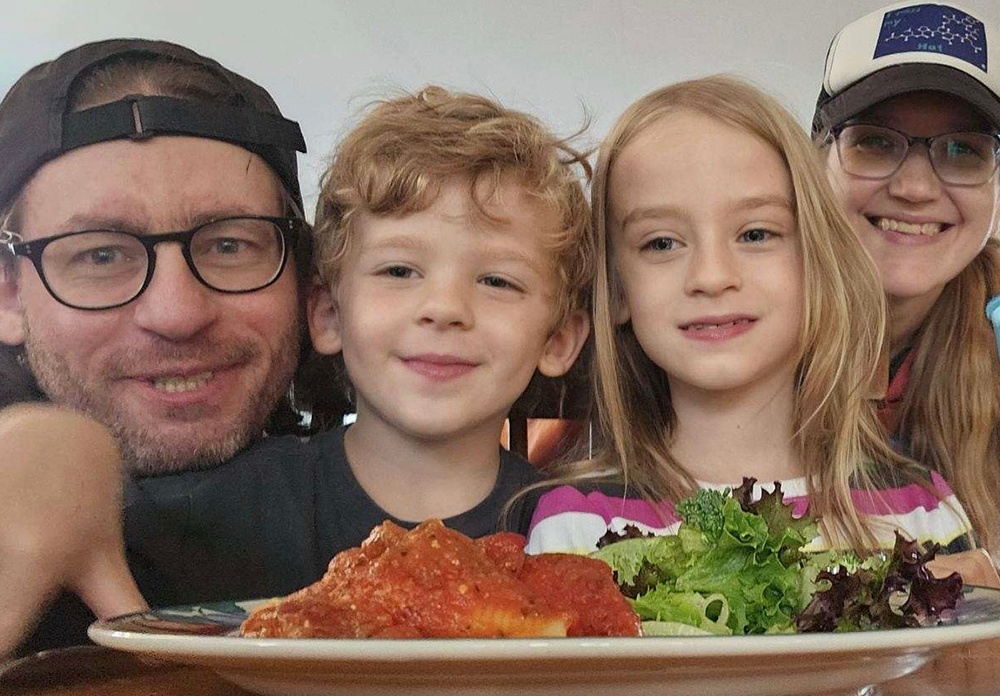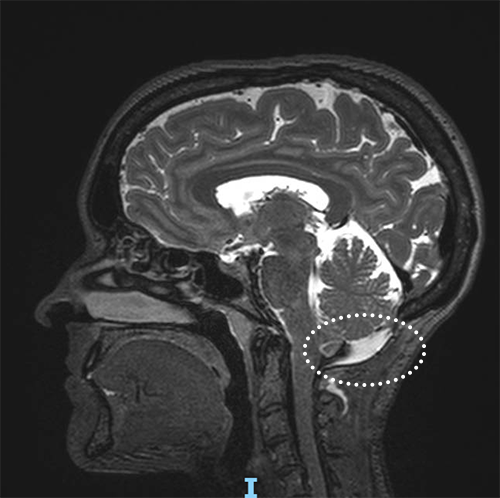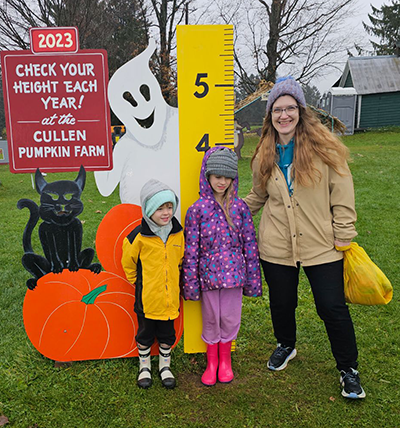
Abby Oberriter loves nothing more than hiking on local trails with her husband and their two children. On days when she’s not exploring nature, she’s playing old-time video games, including Dungeons and Dragons (35 years and counting)! Life is pleasant these days — and for that she is so very grateful to Dr. Philip Stieg, who helped her vanquish the Chiari malformation that just a few years ago had been making her life miserable. Although the 43-year-old lives in New Hartford, New York, closer to the Great Lakes than to the Big Apple, it was well worth a trip to Weill Cornell Medicine Neurological Surgery for treatment.
It started back in 2016, when Abby began to experience neck pains at the base of her skull. As time went on, she developed what she calls “cough headaches” — excruciating head pain that came on when she would cough, making even a mild head cold cause for alarm.
“By 2018 those headaches were so incapacitating that I was terrified every time I got a cold that I might cough while driving and trigger one of them,” Abby recalls. “Though they passed after a couple of minutes, the pain would be so excruciating that I’d have to pull over to avoid an accident. And I had an hour commute each way, so this was no small concern.”
“They said I was fine, that it was just migraines. I knew it wasn’t.”
Abby had had migraines before, so she knew these were different, but she had trouble getting doctors to listen to her. “I couldn’t play games like tag with my children anymore,” she recalls. “Just jumping on the trampoline would trigger the pain.” And as time progressed, there were other symptoms. Trouble sleeping. Exhaustion. Earaches. Dropping things. Her doctors suggested she see a gastroenterologist for reflux, a dentist for the ear pain, a sleep specialist about the fatigue.
In 2020, with pain so excruciating she feared she was having an aneurysm, Abby went to an emergency room, where she had a CT scan. Even then she didn’t get good answers.
“They said I was fine, that it was just migraines,” Abby recalls. “I knew it wasn’t.” By that time she was experiencing headaches that lasted upwards of 20 minutes, which she describes as feeling “like my head was being crushed in a vise. It was so intense I’d drop to my knees on the floor with my head in my hands, moaning in pain.”
Abby had done a lot of online research looking for answers, and she wondered about Chiari malformation. “I raised the idea of Chiari to my neurologists,” she says, “but they disagreed and said Chiari would have shown up on the CT scan.”
It was the sleep study that turned the tide. “I was diagnosed with central sleep apnea, but it’s unusual for a woman of my age and without a history of stroke to have that. This, combined with my other symptoms — it just didn’t add up. This was ultimately what led the doctor to order an MRI, which clearly showed the presence of a Chiari malformation.”

Abby's MRI scan showed the area of malformation (circled) that was causing her headaches.
Feeling vindicated, Abby took matters into her own hands. “I searched online for ‘Best Chiari Experts in New York State,’” she says. “My search led me to Dr. Stieg, along with his credentials and his decades of experience as a skilled neurosurgeon. I listened to his podcast as well as his webinar about adults with Chiari. I could tell that he was extremely knowledgeable and was the one I needed to consult with about my symptoms and the possibility of surgical intervention. And even though I lived five hours away from New York City, I knew it would be worth it to have an expert consult on my case.”
“Chiari malformation can cause a variety of symptoms due to its location,” says Dr. Stieg, the Margaret and Robert J. Hariri Professor of Neurological Surgery at Weill Cornell Medicine Neurological Surgery and the Chair and Neurosurgeon-in-Chief of NewYork-Presbyterian/Weill Cornell Medical Center. “There’s an opening at the back of your head, just above the neck, that houses the connection between the brain and spinal cord. This connection is normally surrounded by cerebrospinal fluid (CSF), which moves freely between the head and spine. When someone has a Chiari malformation, the back of the brain is pushed down through that hole, restricting the fluid’s movement and leading to a buildup of the CSF. That puts pressure on the spinal cord and disrupts how the brain communicates with the rest of the body. That’s what was causing Abby’s symptoms.”
Abby was certainly ready for a Chiari expert. “The uncertainty, chronic pain and fatigue took a toll on my mental health,” she says. “I was irritable, anxious, and depressed. When you’re having trouble making it through the day, it’s hard to look forward to the next. It was even harder to imagine myself surviving another fifteen years — to retire, or see my kids grow up. I spent days and nights crying to family and friends about how I couldn’t handle the physical and emotional stress.”
“Every patient deserves answers as to why they’re in pain,” says Dr. Stieg. “But the rarity of Chiari can be a roadblock. Doctors who only cross paths with one Chiari patient a year, or in a lifetime, may not be familiar with it, or even recognize it right away. And they don’t get some of the nuances of Chiari, such as knowing that Chiari malformation is most visible on an MRI — not on a CT scan.”
With the MRI scans in hand and the patient in front of him, Dr. Stieg and his team had what they needed to make a recommendation. Dr. Stieg warned Abby that she may have already had some nerve damage from the Chiari, and he couldn’t guarantee that surgery would reverse it. But he could relieve many of her current symptoms.
“After taking a look at Abby’s scans, we ascertained that she had Chiari malformation 1.5, an advanced form of CM-I,” says Dr. Stieg. “It’s rarer, and treating it requires a medical center like ours. My team and I were convinced that an approach utilizing posterior fossa decompression would relieve or improve a lot of her symptoms and prevent further progression.”
"A few hours after the surgery, I realized the numbness in my hands was gone. Gone! Like magic!”
“Dr. Stieg answered all my questions thoroughly during the consultation,” says Abby. “I had a wonderful experience with him and all of the doctors, residents, nurses, and support staff. Dr. Stieg’s nurse practitioner, Elaine, was always very responsive to any questions or concerns that I voiced to her. Even if I had questions for Dr. Stieg, she would quickly relay them to him and get back to me quickly.”
Less than a month after her first meeting with Dr. Stieg, Abby was back at NewYork-Presbyterian/Weill Cornell Medical Center. It was right in the nick of time. “Just rolling over in bed triggered my headaches,” she recalls. “I even started drooling and had difficulty swallowing. Every time I took a drink of water or juice, I choked.”
Abby was nervous, but she was motivated to push through. “The only surgery I’ve had before was an emergency C-section in 2015. I was nervous — I had no idea how much pain I might be in or what the recovery period would be like. But I told myself that a few weeks or months of pain would definitely be worth it if I could play with my children and enjoy life again.”

Decompression surgery for Chiari removes the section of bone that's causing the pressure, and the pain. Abby's post-surgical scan shows the area (circled) where the pressure has been relieved.
“We know any neurosurgery is intimidating for patients, but we have so much experience in Chiari that this surgery was routine,” says Dr. Stieg. “We performed the decompression, which starts with an incision at the back of the head in order to remove pressure. We also performed a C1 laminectomy to remove the back of the vertebrae. We followed that with duraplasty, which opened up the dura — the tissue that protects the brain and spinal cord. These all ultimately reduced the pressure on her brain by a significant amount. We were confident she’d feel back to normal again.”
“The surgery was nowhere near as difficult or as painful as I’d feared,” says Abby. “Immediately after surgery, I could already tell that some of my symptoms were gone. With the first sip of cranberry juice I took, I commented to my husband, ‘I didn’t choke!’ A few hours later, I realized the numbness in my hands was gone. And though my neck was sore and stiff, it was nothing like the Chiari headaches and neck pain I had previously experienced. Gone! Like magic!”
Abby was released from the hospital just three days after her surgery. “Back home, I was especially careful about following Dr. Stieg’s orders: no bending, twisting, lifting, or straining,” she says. “But I managed with a little help from family and friends! I’d had some unusual symptoms that resolved, but the only other things I felt were a little bit of neck stiffness, mild headaches, and some pain when swallowing. Everything improved. And through it all, I always felt supported by the neurosurgery team. They always had my back and I never felt alone in dealing with any issues that came up.”

With Chiari behind her, Abby is back to having fun family adventures.
With her journey over, Abby is back to her old self. And back to enjoying life with her family.
“Before the surgery, I was consistently depressed and anxious, and it was often a struggle to make it through the day. The physical limitations, chronic pain, and exhaustion left me feeling guilty for not being able to be the partner and mother that I wished I could be. My physical complaints and emotional struggles have completely resolved and I’ll finally be able to enjoy time with my children the way I always wished I could. I’m looking forward to all the exciting new adventures we can have!”
For this adventure, Abby got her perfect ending. And as an epilogue, she has some words for anyone going through this: “Fortune favors the brave! Surgery was absolutely the right choice for me. I have no regrets at all and will be forever grateful to Dr. Stieg, Elaine, and the neurosurgery team at Weill Cornell for having properly diagnosed and treated me. I hope that sharing my story gives hope to others who have possibly been suffering for years as a result of their Chiari as I was — and reassurance that although ‘brain surgery’ sounds scary, it can be very safely done in the hands of the right experts, and the recovery period is very manageable.”
More about Chiari malformation
More about the Chiari CARE program at Weill Cornell Medicine